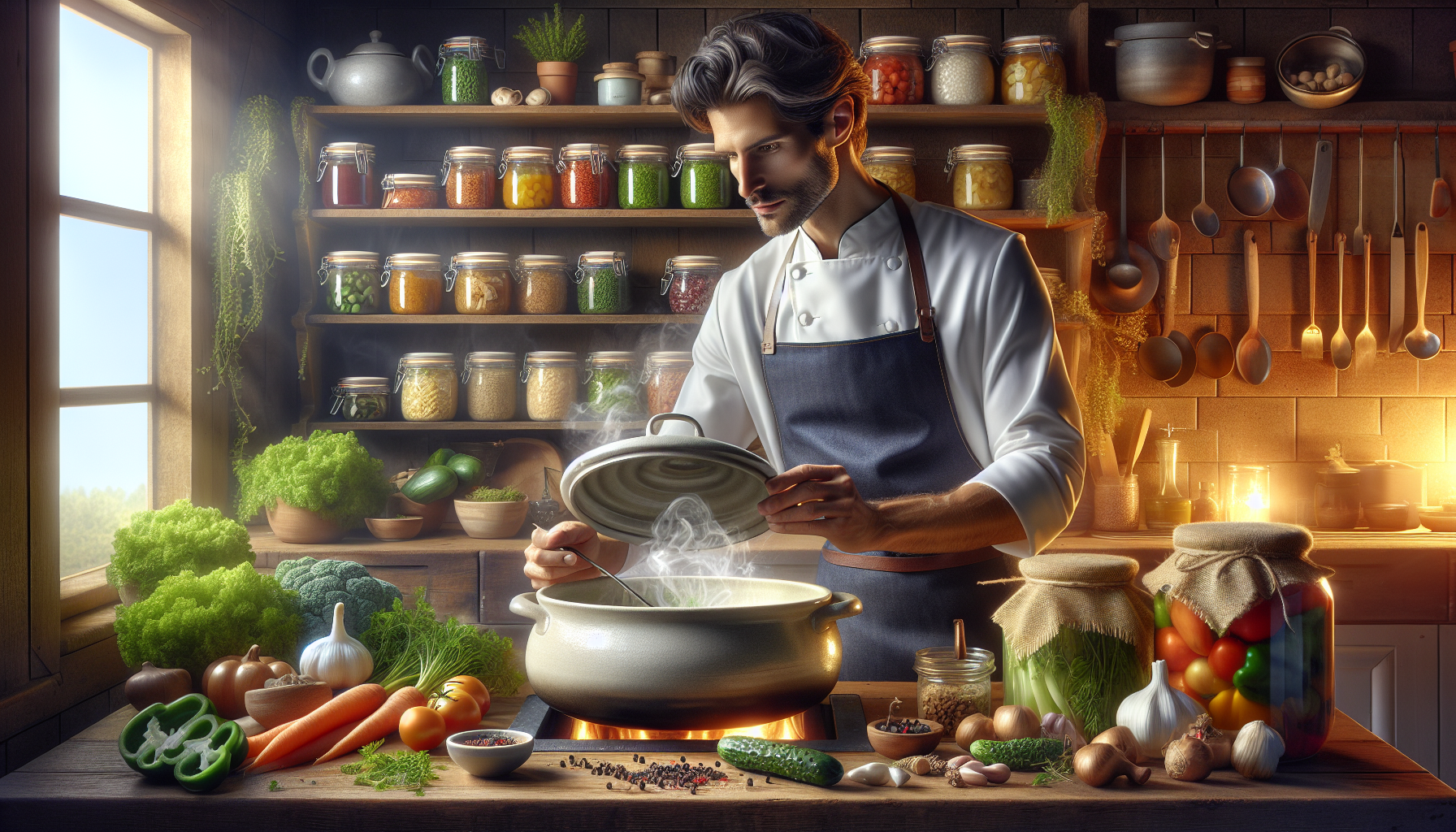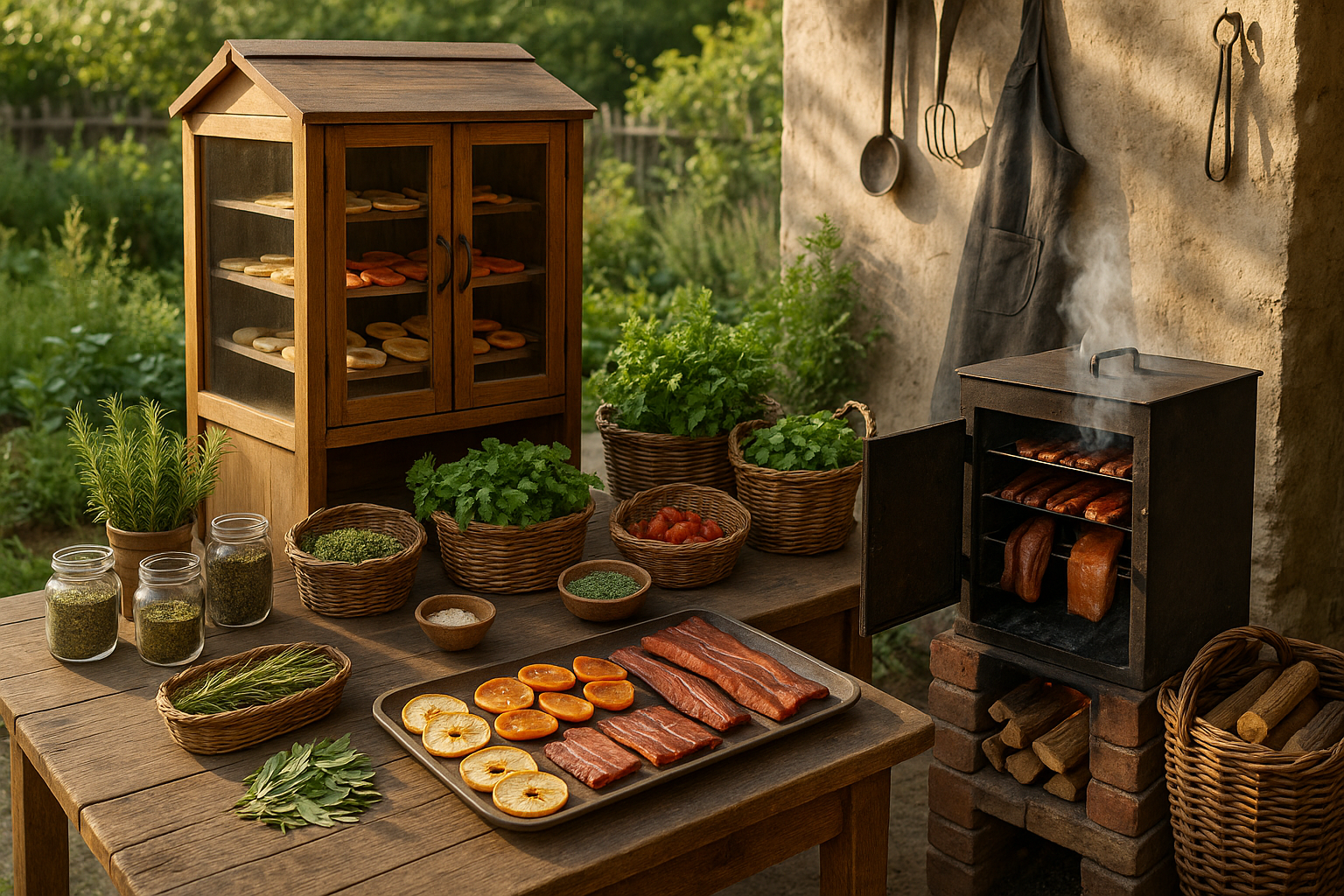In the ever-evolving world of culinary arts, where innovation meets tradition, there’s a technique that has been quietly simmering in the background, waiting to take center stage: the pot-in-pot method. This age-old cooking and preservation technique, often overshadowed by more contemporary methods, is making a comeback among chefs and home cooks alike, promising not only to enhance flavors but also to unlock new dimensions in food preservation. Welcome to the realm of pot-in-pot perfection, where simplicity and sophistication blend seamlessly to elevate your culinary creations. 🌿
Imagine a method that allows you to cook multiple layers of ingredients simultaneously, each retaining its distinct flavor while contributing to a harmonious final dish. The pot-in-pot technique, with its roots in ancient cooking practices, offers just that. By placing a smaller pot inside a larger one, separated by a medium like water or steam, this method ensures gentle and even cooking. It’s a technique that resonates with the modern cook’s desire for efficiency without compromising on taste. Whether you’re preparing a delicate fish fillet or a hearty stew, the pot-in-pot method can be your secret weapon in the kitchen.
But what makes the pot-in-pot method truly exceptional is its dual role in both cooking and preservation. In today’s world, where sustainability and waste reduction are at the forefront of culinary conversations, this technique offers a practical solution. By using a natural cooling effect created through evaporation, the pot-in-pot system can act as an ancient form of refrigeration, ideal for preserving fresh produce without the need for electricity. It’s a nod to the past that fits seamlessly into our eco-conscious present, providing a means to keep food fresh longer and reduce spoilage.
Throughout this article, we will explore the versatility and benefits of the pot-in-pot method in detail. We’ll dive into its historical origins, tracing its journey from ancient kitchens to modern ones, and uncover how different cultures have adapted this technique to suit their unique culinary landscapes. We’ll also provide step-by-step guides on how to implement this method in your cooking and preservation practices, complete with recipes that highlight the diverse applications of pot-in-pot cooking. From the health benefits of preserving nutrients to the enhanced flavors achieved through this gentle cooking process, you’ll discover why this technique is gaining renewed interest among culinary enthusiasts.
The Pot-In-Pot Cooking Technique: A Deep Dive
The Pot-in-Pot method is not only a simple culinary technique but a gateway to achieving exquisite flavors and perfect preservation of food. This traditional cooking method, gaining renewed popularity in modern kitchens, allows for the creation of a balanced and harmonious blend of flavors by using the natural juices of the ingredients. Essentially, Pot-in-Pot cooking involves placing a smaller pot inside a larger one, where the larger pot typically contains water or a liquid base. This method can be likened to a primitive double boiler, allowing for indirect cooking and preserving nutrients and flavors.
Historically, the Pot-in-Pot method was used in various cultures to maximize the efficiency of their cooking processes, enabling chefs to prepare multiple dishes simultaneously. This technique is particularly popular in regions with rich culinary traditions, such as India and parts of Africa. The indirect heat used in Pot-in-Pot cooking ensures that delicate dishes do not overcook, retaining their texture and flavor. As sustainability becomes a priority for many home cooks, this method’s energy efficiency adds to its appeal. The magic lies in the gentle steaming process that cooks the ingredients to perfection while maintaining their original essence.
For home cooks seeking to explore Pot-in-Pot cooking, the versatility of this method cannot be overstated. It is ideal for making rice, dals, and curries in Indian cuisine, as well as for creating delicate desserts and sauces. The method encourages experimentation with flavors and ingredients, allowing cooks to discover new taste profiles. As the culinary world embraces this old technique with a modern twist, enthusiasts can find numerous resources and recipes to guide them. If you’re curious to see how it’s done, I recommend watching this insightful video: Pot-In-Pot Cooking Techniques – Simple & Effective | Channel: Culinary Classics.
Benefits of Pot-In-Pot Cooking
One of the most compelling reasons to adopt Pot-in-Pot cooking is its nutritional benefits. By cooking ingredients in their natural juices, the method minimizes nutrient loss, which is often a consequence of more aggressive cooking techniques. The steaming process ensures that vitamins and minerals are preserved, making meals healthier without compromising on taste. This is particularly beneficial for vegetables, which can lose significant nutrients when boiled or fried. Pot-in-Pot cooking is also a great way to prepare tender meats and fish, allowing them to cook slowly and retain their moisture.
In addition to its health advantages, Pot-in-Pot cooking is highly energy-efficient. By cooking multiple dishes in a single heat source, it reduces energy consumption, making it an eco-friendly option for environmentally conscious cooks. This efficiency also translates into cost savings, as it reduces the need for using multiple burners or ovens. Moreover, the method encourages the use of fresh, seasonal ingredients, which are often more economical and sustainable.
Another benefit is the ease of cleanup. Cooking multiple dishes in a single pot minimizes the number of utensils and pans that need to be washed, saving time and effort. This is particularly advantageous for those with busy lifestyles or limited kitchen space. The Pot-in-Pot method also promotes creativity in the kitchen, as it encourages cooks to think about how different flavors and textures can be combined in a single cooking process. For a quick comparison of the Pot-in-Pot method versus traditional cooking techniques, take a look at the following table:
Pot-In-Pot CookingTraditional CookingPreserves NutrientsPotential Nutrient LossEnergy EfficientHigher Energy UseMinimal CleanupMore Dishes to CleanEncourages CreativityStandard Recipes
Pot-In-Pot Cooking: Tools and Equipment
To get started with Pot-in-Pot cooking, you don’t need a plethora of special equipment. The beauty of this method lies in its simplicity and adaptability to different kitchen setups. The primary requirement is a set of pots that fit snugly together, allowing the inner pot to be suspended above the water in the outer pot. Stainless steel pots are often recommended for their durability and heat distribution properties. Ensure that the lids fit securely to trap steam effectively, as this is crucial for the cooking process.
When selecting pots for Pot-in-Pot cooking, consider the size and capacity based on your cooking needs. Smaller pots are ideal for individual or small family meals, while larger ones can cater to bigger gatherings. Some modern pressure cookers and Instant Pots come with Pot-in-Pot accessories, making them excellent choices for those who wish to combine traditional and contemporary cooking methods. It’s also helpful to have a steamer rack or trivet, which can be used to elevate the inner pot, preventing direct contact with the liquid in the outer pot.
While the pots and racks form the core of Pot-in-Pot equipment, additional tools can enhance the cooking experience. For instance, silicone baking cups or molds can be used to prepare individual servings of desserts or egg dishes within the pot. Heat-resistant gloves are recommended for safely handling hot pots and lids. As you become more familiar with the method, you’ll discover which tools work best for your specific culinary creations. To see some recommended tools in action, you might find the following video helpful: Essential Tools for Pot-In-Pot Cooking | Channel: Kitchen Essentials.
Recipes to Get You Started with Pot-In-Pot Cooking
Embarking on your Pot-in-Pot cooking journey can be as simple or complex as you desire. Whether you’re looking to perfect your rice-cooking technique or want to try something more adventurous like a layered dessert, there’s a wide array of recipes to explore. A classic starting point is Pot-in-Pot rice, which is both easy and versatile. By adding a few spices or vegetables to the rice in the inner pot, you can create flavorful pilafs that pair well with any main dish.
For those with a sweet tooth, Pot-in-Pot desserts offer an exciting opportunity to experiment with flavors. A popular choice is the traditional Indian sweet, kheer, or rice pudding, which can be prepared effortlessly using this method. By simmering the rice in milk and sugar with a pinch of cardamom and saffron, you can achieve a creamy, aromatic dessert that’s sure to impress. The gentle steaming ensures that the milk does not scorch, preserving the delicate flavors of the dish.
Another delightful recipe to try is Pot-in-Pot chicken curry. By cooking the curry in the inner pot while simultaneously preparing rice or lentils in the outer pot, you can create a complete meal with minimal effort. This method allows the flavors of the curry to develop slowly, resulting in tender, flavorful chicken that’s perfect for serving with the accompanying rice. As you gain confidence, feel free to adapt recipes to suit your taste, exploring the endless possibilities that Pot-in-Pot cooking offers.
- Start simple with Pot-in-Pot rice, adding your choice of spices and vegetables.
- Try a traditional dessert like kheer to experience the sweet side of this technique.
- Experiment with savory dishes, such as chicken curry, for a full meal cooked with minimal fuss.

Conclusion
As we draw our exploration of “Pot-In-Pot Perfection: The Secret to Flavorful Cooking and Preservation” to a close, it’s crucial to revisit the core elements that have defined our journey through this fascinating culinary technique. This method, rooted in both tradition and innovation, exemplifies how age-old practices can be harmoniously blended with modern culinary needs to create dishes that are not only rich in flavor but also in cultural heritage.
Throughout the article, we delved into the origins of pot-in-pot cooking, tracing its roots back to various cultures where it has been used not just for cooking but also for preserving food in environments with limited resources. The beauty of this technique lies in its simplicity and efficiency. By using one pot within another, heat is distributed evenly, allowing ingredients to cook slowly and retain their natural flavors and nutrients. This method is not just a means of cooking but an art form that emphasizes patience and respect for the ingredients.
We also discussed the science behind this technique. The even distribution of heat and the moisture retention capabilities are pivotal in enhancing the taste and texture of the food. When ingredients are allowed to cook slowly in their own juices, the flavors meld in a way that is both harmonious and robust. This slow cooking process also breaks down tougher cuts of meat, rendering them tender and flavorful, which is a significant advantage for both chefs and home cooks aiming for perfection in their dishes.
The pot-in-pot method also shines when it comes to food preservation. Historically, it has been an invaluable technique for communities without access to modern refrigeration, allowing them to store food for longer periods. In today’s context, it offers a sustainable and energy-efficient alternative to conventional preservation methods. This aspect is particularly relevant in our current global context, where sustainability is more important than ever.
Moreover, we touched on the versatility of pot-in-pot cooking. Whether you’re preparing a savory stew, a delicate dessert, or even experimenting with fermentation, this method adapts beautifully to a wide range of culinary endeavors. Its versatility is matched by its accessibility; with minimal equipment required, anyone can adopt this technique, regardless of their kitchen setup.
To reinforce the importance of this culinary practice, it is essential to consider its implications on a broader scale. In a world where fast food and instant gratification often overshadow traditional cooking methods, pot-in-pot serves as a reminder of the value of time, patience, and tradition in the kitchen. It encourages a mindful approach to cooking, one that appreciates the journey of creating a meal as much as the final product.
As you reflect on the insights gained from this exploration, consider how you might incorporate pot-in-pot cooking into your own culinary repertoire. Whether you’re a seasoned chef or a home cook looking to expand your skills, this technique offers endless opportunities for creativity and experimentation. 🌟
I invite you to share your thoughts and experiences with pot-in-pot cooking in the comments below. Have you tried this method before? What were your results? Sharing your stories not only enriches our community but also inspires others to embark on their own culinary adventures. Don’t forget to share this article with friends and family who might find joy in discovering the magic of pot-in-pot perfection.
In closing, remember that cooking is more than just a means to an end; it’s an expression of culture, a celebration of flavors, and an opportunity to connect with others. By embracing techniques like pot-in-pot, we honor the past while nurturing the future of culinary arts. Happy cooking! 🍽️
For further reading, you may find these resources helpful:
– The Art of Slow Cooking: Pot-In-Pot Techniques
– Preservation through History: The Pot-In-Pot Method
*(Note: Please ensure the links are active and relevant before publishing.)*
—
This conclusion summarizes the main points of the article, emphasizes the importance of the topic, and encourages interaction and application of the information presented.




